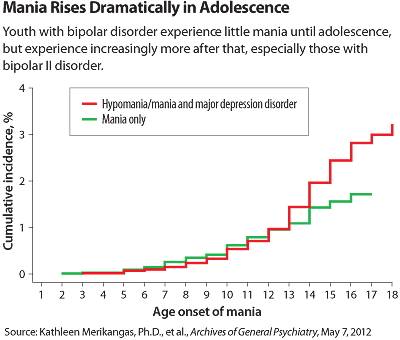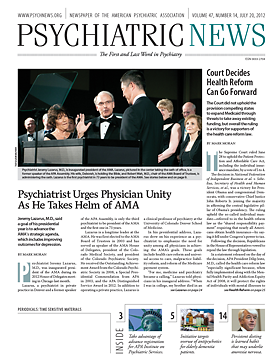Bipolar disorder appears to be almost as prevalent among America’s youth as among its adults, a new study suggests.
The lifetime prevalence rate of bipolar disorder among American adults is 3.9 percent, and the 12-month prevalence rate is 2.6 percent, according to the National Comorbidity Survey Replication, which was published in the June 2005 Archives of General Psychiatry. New data from this study show that 2.5 percent of American youth aged 13 to 18 have received a bipolar disorder diagnosis as well, and 2.2 percent of them were found to have the disorder within the 12 months prior to the study.
“That the prevalence of bipolar disorder in youth approaches the magnitude that has been observed in adults underscores the early onset of this condition in the general population,” the researchers stated in a report published online May 7 in the Archives of General Psychiatry.
The lead investigator was Kathleen Merikangas, Ph.D., chief of the Genetic Epidemiology Research Branch at the National Institute of Mental Health (NIMH) Intramural Research Program.
Still another interesting result to emerge from the study was the increasing prevalence of bipolar disorder with age. For example, while only 2.1 percent of 13- to 14-year-olds had experienced bipolar II disorder—the traditional form of the illness, with episodes of both mania and depression—3.1 percent of 17- to 18-year-olds had. In addition, while 1.4 percent of 13- to 14-year-olds had experienced bipolar I disorder (mania only), 2.7 percent, or double the number of 17-to 18-year-olds had.
These findings have important clinical implications, the researchers pointed out. For instance, the results “highlight adolescence as the peak period of onset of mania. … [Thus] the assessment of mania should receive greater attention in the evaluation of mood changes and disorders in adolescents in the community and in treatment settings that occur outside the mental health specialty sector. Detection of mania is particularly important in light of the substantial evidence for inadequate recognition of ‘hidden bipolarity’ that could lead to ineffective or even harmful treatment approaches. …”
And more than 1 in 5 youth who had experienced bipolar II disorder made a suicide attempt, the researchers learned. This finding “is quite alarming in light of the young age and community setting of this sample,” they asserted.
The study was titled the National Comorbidity Survey Adolescent Supplement. It included some 10,000 American adolescents, aged 13 to 18, representative of the United States general population. Study subjects were given a modified version of the World Health Organization Composite International Diagnostic Interview version 3.0, a structured interview administered by trained lay interviewers to generate
DSM-IV diagnoses. The study was funded by NIMH.


